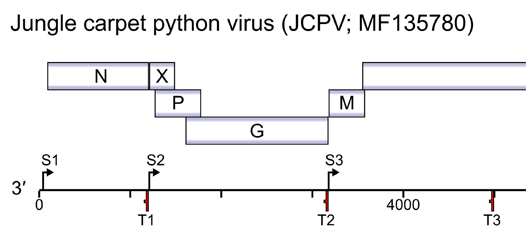Abstract
Tissue samples from Australian carpet pythons (Morelia spilota) with neurological disease were screened for viruses using next-generation sequencing. Coding complete genomes of two bornaviruses were identified with the gene order 3’-N-X-P-G-M-L, representing a transposition of the G and M genes compared to other bornaviruses and most mononegaviruses. Use of these viruses to search available vertebrate genomes enabled recognition of further endogenous bornavirus-like elements (EBLs) in diverse placental mammals, including humans. Codivergence patterns and shared integration sites revealed an ancestral laurasiatherian EBLG integration (77 million years ago [MYA]) and a previously identified afrotherian EBLG integration (83 MYA). The novel python bornaviruses clustered more closely with these EBLs than with other exogenous bornaviruses, suggesting that these viruses diverged from previously known bornaviruses prior to the end-Cretaceous (K-Pg) extinction, 66 MYA. It is possible that EBLs protected mammals from ancient bornaviral disease, providing a selective advantage in the recovery from the K-Pg extinction. A degenerate PCR primer set was developed to detect a highly conserved region of the bornaviral polymerase gene. It was used to detect 15 more genetically distinct bornaviruses from Australian pythons that represent a group that is likely to contain a number of novel species.
Author summary
Unlike plants and animals, viruses don’t leave fossilised remains that can be used to study their ancient history. Rarely, however, some virus sequences end up as integrated copies in host genomes. These ‘fossilised’ virus sequences provide a window into virus evolution on a geological time scale. In this study, we identified bornaviruses in pythons, some of which had neurological disease. Bornaviruses have been associated with persistent neurological infections in a variety of mammalian and avian hosts. Here, we reveal that bornaviruses are associated with similar disease in reptiles as well. These new snake viruses turned out to be most closely related to bornavirus-like sequences that integrated into the DNA of mammals prior to the major extinction event at the end of the age of dinosaurs, the end-Cretaceous (K-Pg) extinction, 66 million years ago, allowing us to infer details of their prehistoric evolutionary history and origin. We also developed a test to detect these viruses from samples collected from live snakes, and used it to identify more related snake bornaviruses, indicating that this group will likely continue to expand.
